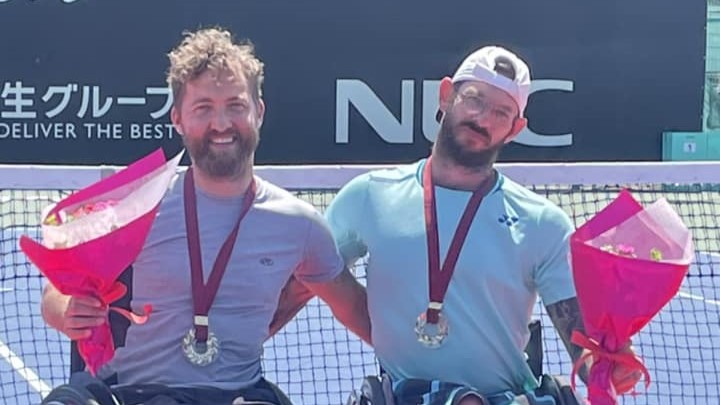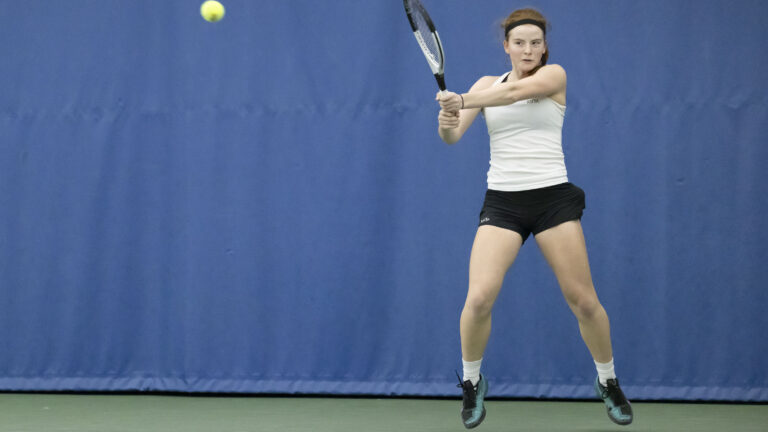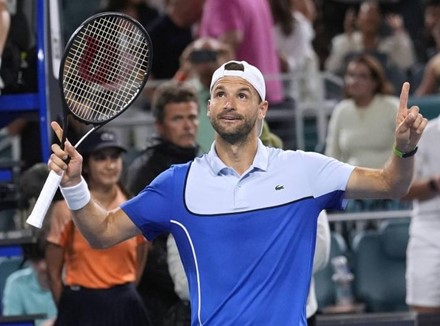
Roger Federer and Rafael Nadal have become very familiar to Roland Garros tennis fans – Federer is playing the tournament for the 17th time while this is No. 11 for Nadal. Both have not missed it since their initial visits in 1999 and 2005 respectively.
On Monday, Federer headed onto Court Philippe Chatrier at one set apiece with Gael Monfils after their match had been postponed the previous night.
He finished off the round-of-16 win efficiently, taking the last two sets with hardly any hiccups, breaking in the first game of both sets to finally win 6-3, 4-6, 6-4, 6-1.
Yours truly was fortunate enough to be sitting down near the court in media seating just two places away from Federer’s father Robert.
It is quite surprising, after all these years of unrivaled success, that momma and papa Federer still get very nervous when their boy is out on court. It’s like he was 12 years old again the way his mother Lynette watches so intently. It almost seems as if she twitches a little bit every time he strikes the ball.
As for papa, he’s much the same as is everyone in the Federer camp. The one real nervous moment on the day was when their man faced a break point serving at 30-40 leading 4-3 in the third set. When he cracked a 193 km/hr ace, there was an immediate burst of emotion from his camp.
Robert Federer, who had been quiet, said, “c’mon Rogie, come on now,” and agent Tony Godsick used just one word to describe what had just happened – “mega.”
The Federers almost never sit side-by-side but they do talk, Lynette leaning over behind Godsick to make the occasional comment to her husband.

Being down near the court for both days of the Federer match, it was possible to note a couple of things. 1. Because both Federer and Monfils don’t grunt very much, you can clearly hear the ‘scuffle scuffle’ of the feet on the terre battue. It’s a much softer, nicer sound than the squeaking of shoes on hard courts. 2. There’s that slight pause in Federer’s service action – with the racquet pointing up before he drops it to the back-scratch position – that’s kind of the icon of the Federer delivery.

The one disappointing thing about the match was Monfils (above getting treatment for a stuffed-up nose) – revealing he was sick on Sunday, had slept poorly overnight and didn’t feel well with cold and flu-like symptoms both days.
Maybe the most interesting things that Monfils said in his media conference were concerning Wimbledon and grass-court tennis. “I have a psychological block on grass,” he said. “I’ve hurt myself quite a few times and I can’t get over this psychological block.”
He is 9-6 overall in his career at Wimbledon. When asked about playing Davis Cup for France at Queen’s Club on grass in London the week after Wimbledon, he suggested that he would be the fifth man – available if someone else couldn’t play. Bu he added that with typical Monfils insouciance that if the team needed a “joker” (wild card) for a possible deciding fifth match, then maybe he might be the man.
Federer, into his 11th quarter-final at Roland Garros – only in 2009 did he win three more matches and take the title – will face compatriot Stan Wawrinka on Tuesday in Court Suzanne Lenglen. He takes a 16-2 record into the match but he was remarkably candid about the last three matches against his 30-year-old fellow Swiss.
Regarding his four-set win in the Wimbledon quarter-finals last year, Federer said, “he was ill at the start of the week” to explain why Wawrinka faded after playing strong tennis for the first two and a half sets. Then about his memorable – four match points saved – 4-6, 7-5, 7-6(6) win in the ATP World Tour Finals semifinals in London last November, he noted, “both of us played well.” Finally, about his 6-4, 6-2 victory over Wawrinka in the Rome semifinals three weeks ago, he said, “I played a very good match…but in the second set he was not as strong as in past matches.” That could partly be because of a letdown for Wawrinka after a monster win over Rafael Nadal in the quarter-finals the previous day.
While Federer will be on Suzanne Lenglen on Tuesday (Kei Nishikori faces Jo-Wilfriend Tsonga in Chatrier), there’s no doubt Nadal’s next match Wednesday against Novak Djokovic will be on Chatrier.
It’s the match-of-the-tournament and maybe the most highly-anticipated Grand Slam quarter-final of all-time – a British journalist sitting nearby called it “galactic.”

On Monday, Nadal completely overwhelmed Jack Sock from the get-go, hitting deep with heavy spin that obviously jolted the 22-year-old American. On Saturday, it was he who had totally dominated 18-year-old Borna Coric with brute power. At one point during the third set when he missed a service return, Sock self-remonstrated, “keep the ball in the court, this guy can’t hurt you with anything.”
With Nadal, it was a totally different story – even if their respective mightily-spun forehands measure at the top of the heap in the plus-3000 rpms. The nine-time champion had, as Sock later admitted, a more ‘live’ ball than anyone he had ever faced.
The match could have ended 6-3, 6-1, 6-4 if Nadal had been able to serve it out at 5-4 in the third set. Instead the final score was 6-3, 6-1, 7-5, 6-2. Nadal later said that he let up a little in the third set, while Sock attributed the turnaround to getting used to Nadal’s unique ground strokes.
Whatever happened, Sock enjoyed the experience, joking to his courtside support group when he came out to play the sixth game of the final set, “this is fun, huh!” And he has announced himself as a potential Top 10 player, although it seems kind of odd that he will likely not be playing on what he described as his favourite surface again until spring 2016.
So the Nadal victory sets up the mammoth quarter-final on Wednesday with both he and Djokovic saying all the right things heading into the confrontation with a 10th Roland Garros title on the line for the Spaniard and a chance to complete a career Grand Slam up for grabs for the Serb.
“It’s the biggest challenge I could ever have on clay,” said Djokovic, who trails their overall head-to-head 23-20 and is 0-6 in meetings with ‘Rafa’ at Roland Garros. But the first three of those were in 2006, 2007 and 2008 when Djokovic was yet a fully-formed champion. In their last three meetings in 2012, 2013 and 2014, Djokovic has won at least one set. The closest match was in the 2013 semifinals when Nadal prevailed 6-4, 3-6, 6-1, 6-7(3), 9-7.
The last time they played was in the semifinals in Monte Carlo in April, with Djokovic winning 6-3, 6-3.
On Monday, Nadal cautioned about interpreting that result incorrectly, saying, “easy result, not that easy a match.”
In what could be interpreted as an indiscretion by the president of the French Tennis Federation, Jean Gachassin, who spoke to Djokovic from his seat in the presidential tribune as Djokovic left the court after his semifinal win over Richard Gasquet on Tuesday, the 76-year-old Frenchman said, about the Serb and the Roland Garros title, “it’s the time – you deserve it.”
Djokovic had just finished doing a post-match, on-court interview in French, as had Nadal about half an hour earlier on Suzanne Lenglen. Despite Spanish being closer to French than Serbian, there’s no doubt Djokovic speaks significantly better French than Nadal. But both are trying this year, almost like politicians, to court the sympathy of the French crowds.
Though he is definitely ahead in the language public relations, it remains to be seen if Djokovic can beat Nadal in the tennis tournament that he has so utterly-owned for a whole decade.
Pospisil last standing in doubles

Vasek Pospisil, playing with Jack Sock, is the only remaining Canadian presence in the Roland Garros main draws after Daniel Nestor exited both the men’s and the mixed doubles on Sunday.
Pospsil and Sock, seeded No. 2, won a competitive, entertaining 7-6(3), 7-6(2) victory over Pierre-Hugues Herbert and Nicolas Mahut of France, the No. 14 seeds, on Sunday.

The French tandem committed to serving and volleying on most points and that was not an easy tactic faced with the returning power of Pospisil, and especially of Sock and his redoubtable forehand. Herbert and Mahut were inspired in front of a supportive crowd, but Pospisil and Sock simply had too much firepower and were able to gain separation with early mini-breaks in both tiebreaks in a match which saw the teams trade the only service breaks in the opening set.
Pospisil and Sock will now face the No. 5-seeded team of Jean-Julien Rojer of Netherlands and Horia Tecau of Romania in Tuesday’s quarter-finals.
Nestor and partner Leander Paes were ousted in their third-round match by the sixth-seeded team of Simone Bolelli and Fabio Fognini of Italy. The score was 6-2, 6-4. Nestor/Paes were well-positioned in the second set when they led 4-2 against the Australian Open champions – but first Paes and then Nestor lost consecutive service games. Paes missed a few volleys when he lost his serve and Nestor double-faulted at 30-30 in the game when he dropped his.
After four losses together in Monte Carlo, Barcelona, Madrid and Rome, Nestor and Paes got on track with their partnership by winning two rounds at Roland Garros.

Nestor has never won the French Open mixed doubles, although he and partner Kristina Mladenovic were runners-up in 2013. They have Wimbledon (2013) and Australian Open (2014) titles together but lost a chance for a Roland Garros victory at Mladenovic’s home Grand Slam when, as sixth seeds, they were eliminated in the second round on Sunday – losing 6-4, 6-3 to unseeded Anastasia Rodionova of Australia and Aisam-ul-haq Qureshi of Pakistan.
Mladenovic, who knocked Genie Bouchard out of the singles in the first round before losing in the third round to unheralded Belgian Alison van Uytvanck, had disappointing results in both mixed and women’s doubles, where, as the No. 3 seed with Timea Babos of Hungry, she was upset by veterans Daniela Hantuchova and Samantha Stosur.
Bouchard enters Rosmalen

Genie Bouchard has taken a wild card into the TOPSHELF OPEN in Netherlands next week. She will likely be the No. 1 seed at the grass-court event. The other top players in the field include Andrea Petkovic, Jelena Jankovic, Elina Svitolina, Belinda Bencic, Camila Giorgi and defending champion Coco Vandeweghe.
Robillard-Millette is Canadian juniors hope

Two Canadians made it through the first round of the French Open junior singles, but only Charlotte Robillard-Millette (above) of Blainville, Que., remains in the hunt.
Robillard-Millette and Katherine Sebov of Toronto, both 16, won their opening round matches on Sunday – Robillard-Millette defeating Monika Kilnarova of Czech Republic 2-6, 6-2, 6-3 while Sebov beat Eva Alvarez Guerrero of Spain 7-6(4), 6-3.

But Sebov (above) did not survive a second-round match on Monday, losing 7-5, 7-5 to No. 8 seed Katie Swan of Britain. It was a competitive match but a few untimely unforced errors turned the tide against the Canadian.

The third Canadian girl in the singles, 14-year-old Bianca Vanessa Andreescu of Toronto, a qualifier, lost her first-round match 0-6, 6-3, 6-2 to No. 16 seed Anna Kalinskaya of Russia on Sunday.
In doubles on Monday, Robillard-Millette and partner Michaela Gordon of the U.S., seeded fourth, advanced to the second round, as did Andreescu and Oleysa Pervushina of Russia. Sebov and Sofya Zhuk of Russia lost a first-round heartbreaker – 10-8 in a match tiebreak – to a French wild card team in a match than ended in near-darkness at close to 9:25 in the evening.
The only boy in the juniors, Alejandro Tabilo, 17, of Toronto, was beaten 5-7, 6-4, 6-1 in the opening round by top seed Orlando Luz of Brazil on Sunday. But he advanced to the second round of the doubles with a victory partnering Felipe Cuhna-Silva of Portugal on Monday.
In singles on Tuesday at 11 a.m. (5 a.m. EDT in Canada), Robillard-Millette will play Tessah Andrianjafitrimo (16 letters) of France.
Paris… Paris… Paris…

The ballboys and ballgirls in Paris are among the best and best-trained in the world.
Here is a group of them getting pre-tournament training from one of the instructors. Probably the only criticism of the Roland Garros ballkids is that they roll (instead of throw) the balls to each other – meaning that on a damp day the balls pick up more moisture (and get heavier) than they would if they were thrown.


